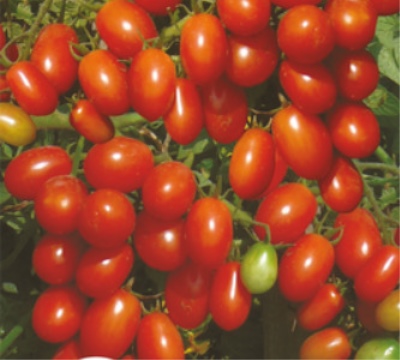
- Category: grade
- Growth type: determinant
- Appointment: fresh consumption, for pickling and preserving, for drying and drying
- Ripening period: early
- Growing conditions: for open ground
- Bush size: undersized
- Bush height, cm: 50-60
- Bush characteristic: compact
- Ripe fruit color: Red
- Fruit shape: plum
Cherry olive is a small fruited new variety. Differs in unpretentiousness and early ripening. They are consumed fresh and frozen, dried and dried, for preservation, for decorating dishes. Suitable for industrial cultivation and landscape design.
Breeding history
A new variety, appeared in 2017.
Description of the variety
The bush is low, reaches 50-60 cm, compact, strong shoots, medium foliage. The root system is small. The first brush is formed after 6-7 leaves. Not prone to tying empty flowers. 15-20 fruits are formed on the brush. The type of growth is determinant. Differs in a high level of fruit formation. They are planted in open ground or in greenhouses. It is possible to grow on the balcony in containers.
The main qualities of the fruit
The size of a classic cherry, weighing about 20 g, resembles an olive or a small plum in shape, smooth dark red, juicy dense pulp, even at the stage of full ripeness, the skin is strong. Contains increased doses of vitamin A, C, folic acid, lycopene.
Taste characteristics
Delicate tomato with a slight sourness, pleasant aroma.
Ripening and fruiting
By the time of ripening, it belongs to the early varieties. The crop is harvested in July-August, 90-94 days after germination. They are distinguished by long-term fruiting, tomatoes are tied before the onset of cold snaps.
Yield
It is considered a high-yielding variety. 2-2.5 kg of cherry are removed from one bush.
The timing of planting seedlings and planting in the ground
Seeds are planted in containers in March, in colder regions in early April. Dive when deploying 2 real sheets. After 55 days after the emergence of shoots, they are transferred to a permanent place. The seedlings should already have 4-6 leaves, the height of the bushes can be from 20 to 40 cm. The night temperature during this period should not fall below +5 degrees, otherwise the seedlings will die. If there is a chance of a cold snap, the seedlings are covered with foil or agrofibre.
For seedlings, holes are dug 25-40 cm deep, a mixture of a mature mullein is poured into each with the addition of superphosphate and wood ash and 1.5-2 liters are poured with settled water. 3 tablespoons are poured onto 1 bucket of mullein. 1 liter of superphosphate and 1 liter of ash - this mixture is enough for 15-20 planting holes. After planting, the garden bed is mulched: sawdust, hay.

Growing tomato seedlings is an extremely important process, because it largely depends on whether the gardener can harvest at all. All aspects must be taken into account, from seedbed preparation to planting in the ground.
Landing scheme
Planted at a distance of 40x60 cm between plants. It is optimal to place small-fruited varieties in rows.

Growing and care
It is considered an unpretentious variety. Prefers sunny places and regular watering - 3-4 liters per plant. After watering, the soil is loosened even under a layer of mulch. The beds are mulched with straw, hay or dried grass. The tomato does not need garter and shaping. It is necessary to remove stepchildren and extra leaves. The lower shoots are removed after the formation of 5-6 inflorescences, 3-4 at a time, usually once a week.
Tomato needs timely feeding, alternating root and foliar. The complex fertilizer "Kemira-Lux" has proven itself well.
During flowering, 1 tbsp is dissolved in 1 liter of water. l potassium sulfate or nitrophoska, then diluted in 10 l and watered plants at the root. During the fruiting period, 1 kg of mullein is dissolved in one bucket of warm water and 5 g of boric acid is added, then watered with 300 ml under the bush.




A plant needs different micronutrients at each stage of growth. All fertilizers can be divided into two groups: mineral and organic. Folk remedies are often used: iodine, yeast, bird droppings, eggshells.
It is important to observe the rate and period of feeding. This also applies to folk remedies and organic fertilizers.
Disease and pest resistance
It is sick less often than medium-fruited and large-fruited varieties. For prophylaxis against late blight and Alternaria, they are sprayed with Ordan: the first time when 4-6 true leaves appear, then a week or ten days later, but no later than 20 days before harvesting. You can spray with an aqueous solution of iodine - dissolve 5 drops in 1 liter. Processing is carried out in the evening hours.


Resistant to adverse weather conditions
Has shown high resistance to return frost.
Growing regions
Suitable for all regions of the Russian Federation, including Siberia and the northern regions.
Review overview
According to gardeners, the seeds of this variety are highly germinating. It does not take much time to care for Cherry olive - the main thing is to water and fertilize on time. Some people recommend using an arc as a support.Of the advantages they call it - the bushes do not take up much space, they look very beautiful with small tasty fruits. Someone likes the taste and dense texture of mini-tomatoes - they do not burst when preserved and do not fall apart even after defrosting.

























































































